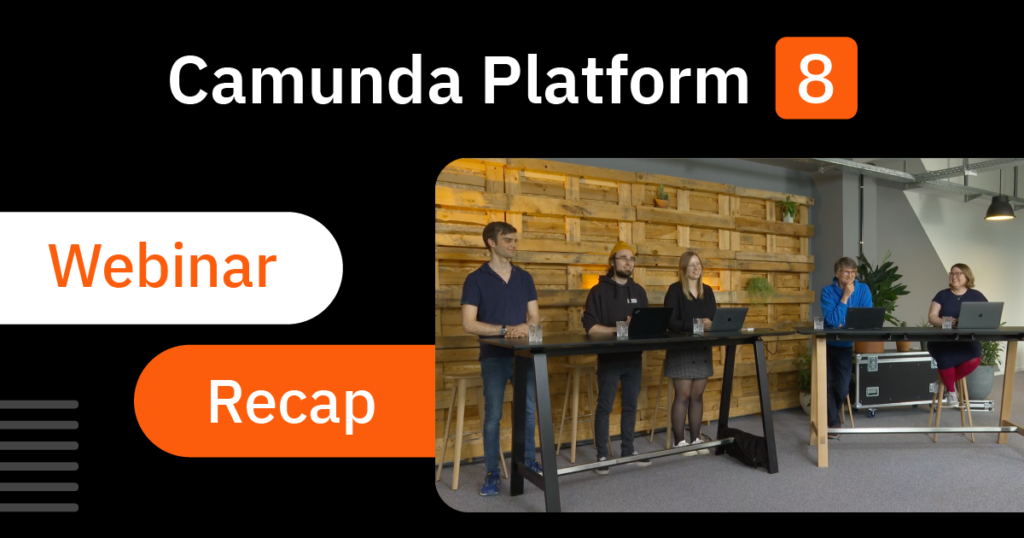Earlier this month, we presented the Camunda Platform 8 release webinar, which included an overarching introduction, live demos from our team, and insights from Camunda’s Co-founder and Chief Technologist Bernd Ruecker. As usual, our audience had lots of questions. We didn’t have time to address everyone’s questions during the live session, so we’d like to share our answers here.
If you’d like to learn more about Camunda Platform 8, you can watch the webinar on-demand or check out Camunda Platform 8 – Orchestrate All the Things.
General questions
Is it possible to migrate existing processes from Camunda Platform 7 to Camunda Platform 8?
Migration is possible. You should consider migrating existing Camunda Platform 7 solutions if:
- You are looking to leverage a SaaS offering to reduce the effort spent on infrastructure setup and maintenance.
- You need performance at scale and/or improved resilience.
- You need features that only exist in Camunda Platform 8, such as:
- BPMN message buffering
- Large multi-instance constructs
- The new connectors framework
- Or the improved collaboration features in Web Modeler
Visit Migrating from Camunda Platform 7 to learn more.
Can Camunda Platform 8 – Self-Managed be hosted in Docker or Kubernetes on a Linux server?
We highly recommend running Camunda Platform 8 – Self-Managed in a Kubernetes environment. Visit Supported environments to learn more.
How do I configure service tasks or script tasks in Camunda Platform 8?
To learn how, visit the Camunda Platform 8 documentation on service tasks and script tasks.
Can I develop my own component to replace the built-in Tasklist in Camunda Platform 8?
You can use the Tasklist GraphQL API to develop a custom application instead of (or in addition to) using Tasklist. Visit Getting Started with Camunda Platform 8’s GraphQL API to learn more.
Will there be feature parity between Camunda Platform 7 and Camunda Platform 8 over the next five years?
The majority of features from Camunda Platform 7 exist in Camunda Platform 8. However, we have identified a few features that will not be included in Camunda Platform 8:
- CMMN modeling support will not be supported, as BPMN is what we recommend and will officially support moving forward.
- Embedded engine and container-managed engine will no longer be supported, as Camunda Platform 8 should be used as a process orchestrator and kept separate from workers and business logic for improved scalability and isolation.
- Runtime data in relational databases is no longer needed. However, business data can remain in such databases and we will ensure that data is reliably and efficiently stored at scale
- Custom application servers are no longer required by Zeebe, Optimize, Operate, or Tasklist.
Web Modeler
Is Web Modeler the same as Cawemo?
Web Modeler is a new modeling tool within Camunda Platform 8. It includes many collaboration features that you know and love from Cawemo, such as the ability to add comments and share BPMN diagrams. It also includes features that are not offered in Cawemo, such as the ability to deploy BPMN diagrams.
What kind of version control does Web Modeler provide?
Web Modeler allows you to save snapshots of diagrams as milestones.
Can comments in Web Modeler generate notifications (such as emails)?
When you mention a user in a comment, they will receive an email notification.
Connectors
Will connectors work with Camunda Platform 8 – Self-Managed Edition?
A connector’s business logic is implemented as a job worker, and its user interface (during modeling) is provided using an element template. In Camunda Platform 8 – Self-Managed, you can employ the concepts of element templates and job workers to build connectors and make them available to your teams.
Is there an SDK that I can use to create custom connectors?
Connectors are currently available as a developer preview. An integration framework (including SDKs) for creating your own connectors is coming soon.
Is it possible to build a custom connector to trigger .NET code?
You can use a client to execute .NET code in Camunda Platform 8. Visit the documentation for the C# client to learn more.
Zeebe
What changes for the process engineer if they start using Zeebe?
Check out Camunda Platform 8 for Camunda Platform 7 Users – What You Need to Know to learn about what might change for you as a process engineer.
How do multiple replicas agree on who is actually processing a message?
In Zeebe, all data is organized into partitions. To read about how data is processed, read our documentation on partitions.
Can Zeebe be embedded in a Spring application or a non-Java application?
We don’t support embedding the Zeebe engine in applications. Visit Moving from Embedded to Remote Workflow Engines to learn more.
Is Zeebe a fork of Activiti?
While Camunda Platform 7 was built on a fork of the Activiti open source project, Zeebe was born and developed right here at Camunda.
Ready to learn more?
Save your seat for our upcoming live demo, An Overview of Camunda Platform 8.

